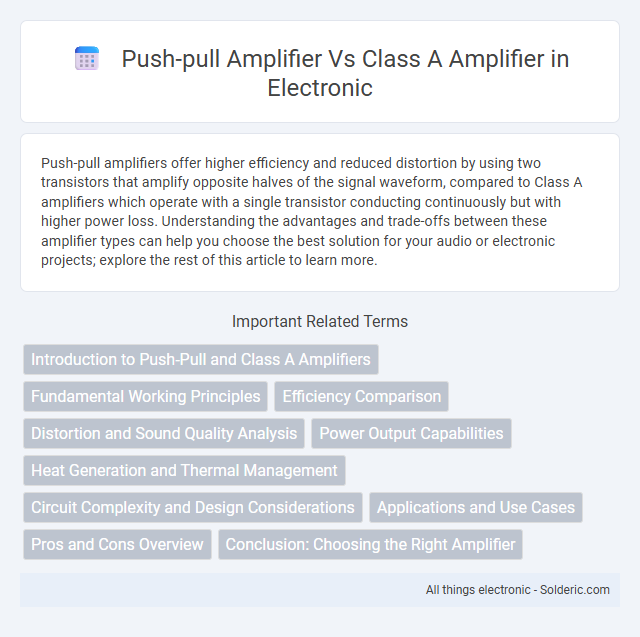Push-pull amplifiers offer higher efficiency and reduced distortion by using two transistors that amplify opposite halves of the signal waveform, compared to Class A amplifiers which operate with a single transistor conducting continuously but with higher power loss. Understanding the advantages and trade-offs between these amplifier types can help you choose the best solution for your audio or electronic projects; explore the rest of this article to learn more.
Comparison Table
| Feature | Push-Pull Amplifier | Class A Amplifier |
|---|---|---|
| Operation Mode | Uses two transistors conducting alternately | Single transistor conducts continuously |
| Efficiency | High (up to 70%) | Low (around 20-30%) |
| Distortion | Low even harmonic distortion | Higher distortion due to continuous conduction |
| Heat Dissipation | Lower heat generation | High heat generation |
| Complexity | More complex circuit design | Simpler circuit design |
| Output Power | Higher power output capability | Lower power output capability |
| Applications | High power audio amplification | Low power, high-fidelity audio |
Introduction to Push-Pull and Class A Amplifiers
Push-pull amplifiers use two transistors working in opposite phases to efficiently amplify audio signals, reducing distortion and power loss. Class A amplifiers operate with a single transistor that conducts continuously, providing high linearity and low distortion but with lower efficiency and higher heat generation. Understanding these differences helps you choose the right amplifier for balance between sound quality and energy consumption.
Fundamental Working Principles
Push-pull amplifiers use pairs of transistors that alternately amplify opposite halves of an input signal, reducing distortion and improving efficiency by canceling out even-order harmonics. Class A amplifiers operate with a single transistor conducting throughout the entire input cycle, ensuring high linearity but causing significant power loss as heat. Your choice between these will depend on whether you prioritize signal fidelity or power efficiency in your audio applications.
Efficiency Comparison
Push-pull amplifiers exhibit significantly higher efficiency compared to Class A amplifiers, often reaching up to 70-80%, whereas Class A amplifiers typically operate around 20-30% efficiency due to continuous current flow even without input signals. The push-pull design minimizes power wasted as heat by alternately driving output transistors, which reduces distortion and energy loss. Optimizing your audio system with a push-pull amplifier can lead to better power utilization and cooler operation under high output conditions.
Distortion and Sound Quality Analysis
Push-pull amplifiers exhibit lower even-order harmonic distortion compared to Class A amplifiers, resulting in cleaner sound reproduction and reduced harmonic coloration. Class A amplifiers, while producing higher linearity and minimal crossover distortion, often generate more heat and consume more power, which can affect sound purity over extended usage. The balanced operation of push-pull designs enhances dynamic range and improves efficiency, making them favorable for distortion-sensitive audio applications.
Power Output Capabilities
Push-pull amplifiers deliver higher power output and greater efficiency by using pairs of transistors that amplify opposite halves of the waveform, minimizing distortion and heat dissipation. Class A amplifiers, though known for superior linearity and sound quality, operate with a single transistor conducting at all times, limiting their power output and resulting in significant energy loss as heat. Consequently, push-pull designs are favored in applications requiring high power and thermal management, whereas Class A amps are preferred in low-power, high-fidelity audio scenarios.
Heat Generation and Thermal Management
Push-pull amplifiers generate less heat compared to Class A amplifiers because they conduct current only during half of the input signal cycle, making them more efficient. Class A amplifiers continuously conduct current, resulting in significant heat generation that demands robust thermal management solutions such as large heat sinks or active cooling. Your choice between these amplifier classes impacts cooling requirements and overall system reliability.
Circuit Complexity and Design Considerations
Push-pull amplifiers feature a more complex circuit design involving complementary transistor pairs or tubes working in tandem to improve efficiency and reduce distortion, requiring intricate biasing and phase-splitting networks. Class A amplifiers utilize a simpler single-ended design with a transistor or tube conducting for the entire input signal cycle, resulting in straightforward biasing but higher power dissipation and thermal challenges. Designing push-pull circuits demands careful matching of components and precise thermal management, whereas Class A amplifiers prioritize linearity with simpler circuitry but face efficiency trade-offs due to continuous current flow.
Applications and Use Cases
Push-pull amplifiers are commonly used in high-power audio applications such as stereo systems and guitar amplifiers due to their efficiency and ability to reduce distortion by canceling even-order harmonics. Class A amplifiers are favored in high-fidelity audio equipment and precision instrumentation where linearity and low signal distortion are critical, despite their lower efficiency and higher heat generation. Push-pull designs excel in situations requiring robust power output and thermal management, while Class A amplifiers are preferred for audiophile-grade sound reproduction and sensitive signal amplification.
Pros and Cons Overview
Push-pull amplifiers offer higher efficiency and reduced distortion by using complementary transistor pairs that amplify both halves of the signal waveform, making them ideal for power-sensitive applications. Class A amplifiers deliver superior linearity and minimal crossover distortion due to their constant conduction, but they suffer from poor efficiency and generate more heat. Your choice depends on whether you prioritize energy efficiency and power output or sound fidelity and simplicity in circuit design.
Conclusion: Choosing the Right Amplifier
Push-pull amplifiers offer higher efficiency and reduced distortion compared to class A amplifiers, making them ideal for power-sensitive applications and larger sound systems. Class A amplifiers provide superior linearity and minimal signal distortion, preferred in audiophile-grade equipment where sound quality is paramount. Selecting the right amplifier depends on balancing power efficiency against audio fidelity requirements, with push-pull suited for performance and class A for pristine sound reproduction.
push-pull amplifier vs class A amplifier Infographic

 solderic.com
solderic.com